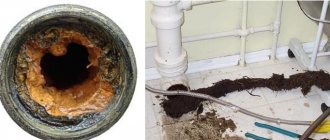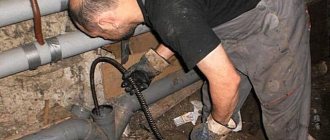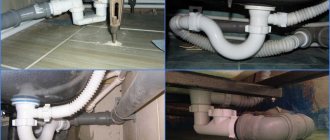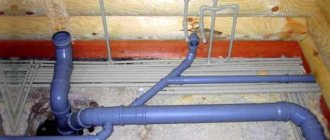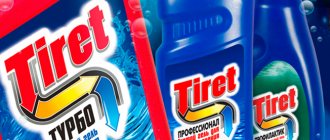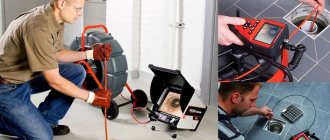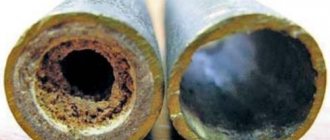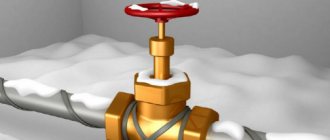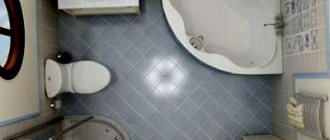Published: 10/7/2012 Category: Plumbing work Views: 6779
Surprisingly, most often the work of a plumber involves more than just installing toilets, bathtubs and sinks. Such work is performed only once every 5–10 years, when they decide to make a major overhaul and replace all the plumbing. The daily work of a plumber is to eliminate malfunctions, breakdowns and imperfections. And there is plenty of work here, believe me.
But in order not to wait for a plumber to come for several days, it is much easier to master at least the basics of plumbing repair yourself, especially since it is not as difficult as it might seem. In this article, we will look at the main and most common methods of clearing blockages, and in subsequent materials we will dive headlong into all the intricacies of installing and repairing plumbing fixtures.
Blockages form in plumbing fixtures (bathtub, toilet, sink, etc.), one might say, all the time; as soon as we start using plumbing fixtures, we immediately create conditions for the formation of a blockage. Blockages are a fairly common problem, which can be eliminated in different ways: from the simplest, requiring the use of only physical force and simple devices, to the very complex, when you need to purchase special equipment.
Causes of sewer blockage
Usually the sewer gets clogged at the most inopportune moment. More often this happens to residents of apartments with old communications. Especially when it comes to old cast iron pipes. This nuisance is associated both with the structural features of the sewer system itself and with the human factor. The first sign of a future problem will be slow drainage of water and, possibly, the appearance of an unpleasant odor from the drain hole. There are five main factors that contribute to pipe clogging:
- Fat blockages – account for 70-80% of all unpleasant cases. Washing machines, dishwashers, and kitchen sinks supply the largest amount of grease clogs into the sewer system. This case is relevant both for residents of high-rise buildings and for owners of private cottages.
Fat deposits gradually accumulate over many years before leading to serious consequences. The accumulation period depends on the quality of the pipe material and the correct installation. Fat deposits are heterogeneous in thickness. Their inner diameter is softer and has a jelly-like consistency, while the outer diameter, which is adjacent directly to the inner wall of the pipe, is very hard. This is explained by the fact that it is gradually reinforced with various fibers that fall into the drains. This could be small threads after washing clothes, hair, particles of undissolved powder and much more. Plus, these stable formations attract and absorb mineral salts from wastewater, which makes them even denser. If your sewer system is also leaky or designed in such a way that there is a draft that moves through the pipes, the fat layer will dry out and thicken even more. The presence of a draft is not the main reason for hardening. This can also occur due to a small amount of passing water. In other words, saving water does not lead to anything good , and the internal cavity of the pipes quickly becomes impassable. Whether your system is sealed or not is very easy to understand. In a negative case, a characteristic unpleasant odor will be present. Fatty blockages are the most persistent and the most difficult to remove. - Mechanical blockages account for only 10-20% of all cases. Mechanical blockages mean various objects that, in principle, should not fall into the sewer. For example, in the process of home renovation, where does the water with the remains of various mortars drain? Of course, into the toilet.
Personal hygiene items and items related to personal care. For example, cotton balls, adhesive bandages, ear sticks and even toilet paper are undesirable items for the sewer system. For all this, there is a trash can in the apartment. But what about the remnants of various solutions? You won’t take them outside and pour them straight into the sewer, right? In this case, it is necessary to thoroughly flush the system and make sure that the dirty water is gone without any residue. In a word - pour more water. Be sure to ensure that children do not throw small objects from toys or construction sets, as well as rags and puzzles into the toilet. For some reason they really love to do this. By the way, grounds from natural coffee, onion peels and peels of vegetables and fruits have a very detrimental effect on the condition of the pipes and contribute to the formation of blockages. This is especially true in the warm season, when there is an abundance of them. - Mechanical damage to the sewer system can occur due to foreign solid objects entering the system. In private homes, external sewer pipes can be damaged by tree roots. They can wrap around the pipe and simply crush it. A chip will form in this place, and its edges, according to the laws of physics, will protrude inward. This will serve as a barrier to the passage of water and will stop various debris, which will lead to the rapid formation of a traffic jam.
- Incorrect installation carried out by inexperienced specialists will definitely make itself felt after some time. A problem may arise if the pipes are located at too sharp an angle or, conversely, have a minimal slope, and also if the wrong, too small cross-section is chosen, or if the ends of the pipes were not cleaned at the junction or soldering points and burrs remained on them.
Such small omissions must be carefully monitored. The sewer drain may not work properly if drain pipes and valves are not installed. Blockages will become very common if the pipe turns are made at right angles, if the pipes are too bent in a small area and have many turns. - Exceeding the service life of the sewerage system. Even if the pipes in your system are installed correctly, but they are many years old, you are still at risk. Only their PVC pipes are practically not susceptible to the formation and retention of fatty deposits on the walls. If you are still using cast iron pipes, then you should know that their internal cavity is susceptible to corrosion, on the surface of which a coating of dirt and grease will happily linger.
By understanding the causes of blockages, in the future you will be able to protect yourself from unwanted consequences and operate your sewer system correctly.
The sewerage is clean, but the water does not drain
This happens, and there is a completely logical explanation for this phenomenon. There may be several reasons:
- Clogged siphon. This is especially common after any repair work has been carried out; construction debris accumulates in the siphon.
- Incorrect bending of the corrugation going from the siphon to the sewer. If in your case the siphon has a bottle shape, then there must be a side outlet and a slightly elongated lower part so that water accumulates; and if the siphon is of a pipe type, then one of the pipes must be curved.
- There are plugs at the joints of silicone pipes. This is possible if the work was not carried out very carefully.
To determine the approximate location of the blockage, open the water and watch how it “disappears.”
What to do if these problems occur? Eliminate the root cause: clean the siphon, check that it is positioned correctly, and carefully remove the silicone plug using sandpaper or the blunt side of a knife.
Most often, traffic jams occur at the places where the pipe first turns, narrows, or connects to the central riser
Sewage clogged areas
To effectively remove the blockage without resorting to the help of specialists, you need to navigate the problem areas. To do this, you need to understand the structure of the sewer system. Let's take a closer look:
- If clogged kitchen sink or washbasin. There is no need to panic, but the first thing you should do is look under the sink. There you will see a siphon, which has a sump in the form of a bowl, from which a pipe goes directly to the riser. In most cases, it is the siphon. Due to the peculiarities of its design, it performs several functions at once: it collects most of the garbage and heavy particles at the bottom of the bowl and prevents the penetration of unpleasant odors from the sewer into the apartment or house. The water that is constantly present in the sump traps these “aromas”. You will understand that the system requires cleaning when so much debris has accumulated in it that there is simply no room left for water, and odors begin to seep through. The first step is to unwind the siphon. You should start from its bottom. Be prepared to be greeted by stench and possibly dirty, dark water flowing. Sometimes the siphon is twisted very tightly. To avoid stripping the threads and damaging it, wrap it in cloth and try again. Be sure to place a basin or bucket under the siphon to prevent dirt from getting onto the floor. And don't forget to wear rubber gloves.
Remove debris from the sump . In the case of a kitchen sink, these will be large pieces of food, onion skins and other food particles. In the case of a bathroom sink , in 90% of cases it will be hair . They may be wrapped around the threaded part and may be difficult to remove. After the accumulations in the sump have been completely removed, it must be rinsed thoroughly with hot running water and only then screwed into place. Turn off the water and see if the water flows well. If there is a result, but it is not sufficient, you need to unscrew the siphon completely. Sometimes it happens that hair gets wrapped around a long screw, which acts as a fastening element. You should unscrew it from the top, and hold the siphon from below so that it does not scroll. - If The bathroom drain is clogged. The main reason for this type of blockage is the large amount of hair that gets into the system while washing your hair. You must perform the same steps as in the previous case. The first thing you need to check is the siphon.
- Less often, but it happens The toilet drain is clogged. This can happen if it is not used properly or if a foreign object gets into the system. We have already said that with frequent and regular flushing of building mortar residues into the toilet, clogging is inevitable.
The same thing will happen if you throw plastic bags, personal hygiene products and used baby diapers down the toilet. If water does not pass through during flushing, it is necessary to unscrew the wide flexible corrugation, which is located at the back of the toilet and is connected to the riser. And with your own hands remove from there a foreign object that interferes with the normal functioning of the system. Cement or plaster residue should also be removed whenever possible. Again, do not forget to place a basin under the corrugation. The drain may not work if the corrugation does not have a slope and is installed almost perpendicular to the drain. Pay attention to this point too. You can fix this problem yourself only by raising the level of the toilet and setting up an impromptu podium. After all, the corrugation is inserted into a ready-made hole in the riser, which is almost impossible to redo.
Clearing a clog using a plunger
Clearing a clogged sink with a plunger
Let's look at the detailed instructions for clearing a clog in the sink using a plunger, shown in the pictures below.
| 1. Take the plunger in your hands | 2. Cover the overflow hole with a rag or seal it with tape |
| 3. Press the plunger to the sink drain hole | 4. Pump the air up and down with a plunger until the water goes away |
Clearing a clogged toilet using a plunger
To clear a clog in the toilet, use a special plunger with a narrow ring at the end, the diameter of which corresponds to the diameter of the toilet hole; a regular plunger is unlikely to help you. Detailed instructions are presented in the pictures below. In order to unclog a toilet using a plunger, there must be enough water in the toilet to cover the plunger. To clean the toilet drain, use strong pushing movements downwards into the drain area. At the same time, water is pushed through due to the air pressure located in the bowl of the plunger. The process will require you to be careful not to crack the toilet and strong enough to push the column of water through effectively.
| 1. Take the plunger in your hands | 2. Insert the plunger into the toilet hole and pump air up and down |
| 3. We continue to pump air until the water begins to pass | 4. Press the cistern flush button to make sure that water begins to flow into the toilet drain |
| 5. If the water is gone, it means everything was done correctly. | |
Ways to clear a clogged drain in an apartment
Before you begin to clear the blockage yourself, you need to assess the full scale of the tragedy. Namely, to understand whether the blockage is local or global. By the way, the latter cannot be cleaned without the appropriate services. very easy to check Open all the taps in an apartment or private house at the same time and see if the water flows out at the same speed everywhere. If, for example, everything is in order in the bathtub and sink, but the water in the kitchen sink is barely absorbed or does not stand at all, then you are in luck. This is a local blockage. If there is a slow outflow of water in all nodes, then the entire system is clogged. First, let's look at methods that can clear a small blockage, and then we'll move on to a more radical method.
No. 1. Flushing pipes with boiling water
The first and most primitive method is to flush the pipes with boiling water. This method is most often used in the kitchen, since boiling water can dissolve a certain amount of fat. You need to pour 3-5 liters of boiling water into the sink and wait 10-15 minutes. Owners of sinks made of polymer materials should be careful here. As is known, some of their species react poorly to high temperatures. Therefore, before resorting to this method, carefully read the instructions for using the product. Boiling water can remove a small blockage caused by a small amount of fat. He will simply take it with him and the problem will go away on its own.
No. 2. Cleaning pipes with baking soda and vinegar
If a more aggressive method is needed, try using products that are definitely available in every home - soda and vinegar . Thanks to the neutralization reaction that occurs when these two components interact, you can get rid of moderate blockages. But it is not recommended to use an overly concentrated solution, otherwise the internal walls of the pipes may be damaged. Cleaning should be done as follows: pour a glass of baking soda into the drain hole. After this, a glass of table vinegar is poured there. The reaction will occur over about 30 minutes . During this time, it is prohibited to open the water and generally use plumbing equipment. When the reaction is complete, rinse the drain with hot running water. Don't skimp on water. Grains of soda sand should be completely washed away from the walls of the pipes along with any contaminants.
No. 3. Removing blockages using special means
If none of the above methods work, you can turn to chemical compounds for help. Any store will recommend you a variety of household chemical solutions intended for these purposes. Please note that plastic sewer pipes cannot be cleaned with any means you like. There must be a special recommendation on the label. The selected liquid must be used strictly according to the instructions and using personal protective equipment. Users of polymer sinks should be careful not to allow the solution to get into the bottom of the sink. It is better to use a watering can to ensure that household chemicals get into the drain hole accurately. Typically, the product must be allowed to stand for a certain time to act on the blockage, and then rinsed with hot or cold water, depending on the recommendations in the instructions.
There are two types of liquids - alkaline and acidic. The former are more suitable for use in the kitchen, because the main element of the blockage is fat. Acidic ones are recommended for use in bathrooms. They are able to dissolve soap residue and hair. You must understand that severe blockages with a large amount of fatty deposits cannot be completely eliminated so easily. In the first paragraph, we wrote that the consistency of fat is different. Now imagine that a standard water pipe, which has a cross-sectional diameter of 50 mm, has fatty deposits 10 mm thick around the perimeter. Larger particles, in turn, can settle on them, which can form blind plugs. The average length of the pipes is about 1 meter. When pouring household chemicals, you cannot guarantee that the liquid will be able to seep through the remaining space unhindered and be evenly distributed along the entire length. Often fat dissolves in a small area and only a soft layer of it. Therefore, the blockage may soon form again. To treat the entire pipe with the solution, you will need a very large amount of it, which will be very expensive.
No. 4. Mechanical method
When household chemicals are powerless, it is necessary to find a way to mechanically influence the blockage. To do this, use a special plumbing cable. With its help, you can easily break through a plug that has formed or even remove a foreign object that, when it gets into the pipe, has blocked the gap. A long cable will help remove clogged pipes in a private home if it is concentrated in the outer part of the sewer system. It is more efficient and convenient to do the work together. It is necessary to provide free access to the internal cavity of the clogged pipe. To do this, you need to unscrew the lower part of the siphon and move it to the side. The cable is a wire of a certain thickness at the end of which there is a handle. One person should hold the cable and slowly turn the handle, while the second should move it along the pipe. It is recommended to perform rotations in one direction.
The cable, moving along the pipe, will bend under the influence of rotational moment, and remove the fatty layer from the walls. Sometimes special attachments in the form of a brush with hard bristles are put on the end of the cable. With such a device, your chances will increase. The cable can only cope with a soft layer. The wastewater, of course, will immediately become easier to flow, but this condition must be constantly maintained.
No. 5. Plunger in the fight against sewer blockage
Another simple device that our grandmothers still continue to use is a plunger. Removing a blockage with its help will be effective provided that the plug is located near the beginning of the drain hole. Working with a plunger is very simple. It is necessary to position the plunger in the sink so that its bowl completely covers the drain. After this, you need to fill the sink with some water. Now move the plunger handle up and down. It is necessary to perform 15-20 such back-and-forth movements. The collected water will serve as an indicator of how effective the cleaning was. If, after you removed the plunger bowl from the hole, the water quickly disappeared, then you have achieved the desired result. If the water flows away slowly, the procedure should be repeated.
No. 6. Hydrodynamic method: when other methods do not work
Now let's look at one of the most effective ways to remove blockages, both in an apartment and in a private house, with the help of specialists. This method should be chosen if none of the above could help you. Special services that professionally provide such services use a machine that eliminates problems hydrodynamically. For pipes of small diameters, there are mobile installations. The hydrodynamic method involves combating blockages using water, which is supplied under high pressure through nozzles of various sizes. The work is carried out in two stages to achieve complete cleaning of the internal cavity of the pipes:
- At the first stage, a hose is used, at the end of which there are large nozzles. They are also called punching ones. The larger their size, the faster the speed of movement of the hose in the pipe. At the first stage, it is necessary to break through the plug and perform preliminary cleaning of deposits.
- The field of this nozzle is changed to smaller ones. Liquid that is sprayed under high pressure will have a stronger impact on the internal walls. At the second stage, small nozzles with a brush-shaped nozzle are used. Cleaning is done very carefully.
This method is used not only to remove large amounts of dense fatty deposits, but also to remove frozen liquid from pipes. Only in this case it is called thermohydrodynamic and instead of cold water, very hot water is used, which almost reaches the boiling point. Work at all stages is carried out in the same way. In the case of PVC pipes, the use of high-temperature exposure is prohibited, because this material remains stable only up to a temperature of 110°C .
In other cases there are no restrictions.
Causes of the problem
Blockages can form in both plastic and metal pipes. The older the drainage system, the higher the likelihood that an obstacle will form in the way of water outflow.
Metal pipes are more susceptible to blockages, since over time a thick layer of rust settles in them.
Reasons for appearance:
- accumulation of food waste, hair, paper and other organic and inorganic debris;
fatty deposits that stick to the walls of the pipe and collect small debris;- limescale deposits formed due to too hard water and impurities in it;
- foreign objects, such as rags, falling into the drain hole;
- improper installation of the drainage system;
- mechanical damage to pipes.
It is not possible to be 100% insured against a blockage; it can occur even in the most careful people who monitor the condition of the pipes and regularly carry out preventive cleaning.
Preventing sewer blockages
To prevent regular blockages in your home or apartment, you must adhere to preventive measures. Although they are not 100%, they will protect you from unpleasant consequences:
- You should not save on water with obvious fanaticism. If the amount of liquid necessary for their natural purification does not enter the sewer pipes, then expect trouble. The sewer system especially needs hot water, which at the initial stage can still cope with light grease deposits and prevent its accumulation. When pouring the remains of rich broth and other similar compounds into the sink or toilet, be sure to rinse several times or turn off the water tap for a few minutes.
- Carefully monitor the liquid level in the sewer wells. This rule primarily applies to owners of private houses. If you are gaping, you can remember this when the contents of the well begin to flow out through the drain holes in the plumbing units. This is especially dangerous if the system is not equipped with a check valve on the outlet pipe, and if this also happens on the ground floor, where the difference in height with the liquid level in the well will be minimal, you will certainly be flooded, you know what. The law of communicating vessels in this case will work instantly.
- Don't use the toilet instead of a trash can. Many plumbers do not recommend throwing even toilet paper into it. At the same time, many users wash off leftover food, sour jam with seeds or compote cake, cat litter, hair from a comb or hair from a pet brush, cotton pads and swabs, personal hygiene products, small household garbage and other most unexpected items. . This is a sure step towards a quick blockage.
- On the kitchen sink drain be sure to install special protective nets. They will prevent large amounts of food waste from going down the drain. Once the mesh becomes clogged, be sure to throw its contents in the trash.
- If your financial situation allows you to purchase a household waste shredder , be sure to do so. The contents of the shredder after use should also go straight to the trash bin.
- You need to install mesh and on the bathroom drain hole. This will prevent hair from getting into the drain, which is the main cause of clog formation.
- Be sure to carry out periodic preventive cleaning using boiling water or vinegar and soda .
- Do not trust the work of laying sewer pipes and arranging the system as a whole to dubious workers .
- Don't forget that all items, and sewer pipes are no exception, have a certain resource . By exceeding it, you doom yourself not only to the risk of failure of the entire system, but also to using water containing rust particles. Change sewer pipes on time.
- Regularly check, doesn't it exceed liquid level in the drain well permissible level.
Remember that blockages always appear unexpectedly and disturb the comfort of the inhabitants of the house. It is much cheaper to purchase meshes for each drain hole than to resort to the expensive services of specialists.
The article was written for the site.
Tags:Sewage, Pipes, Cleaning
Where to order cleaning of complex blockages
Owners of cottages and apartments, as well as various organizations, periodically need the services of a plumber. And every time the question arises - where is it better to turn?
In Moscow and the Moscow region, one of the well-established companies in the field of eliminating leaks and complex pipe blockages is. The presence of qualified personnel and special equipment guarantees high-quality performance of work in the shortest possible time.
You can submit your application by filling out the form below. It is enough to indicate your name and phone number. Our manager will contact you within a few minutes and advise you on all your questions.
Plumber's story
The problem was resolved quickly. Using a cable, the specialist cleared the blockage in a quarter of an hour. As it turned out, it was caused by wet wipes. Of course, I knew that ordinary wet wipes cannot be flushed down the toilet. But mine were special, “soluble in water.”
“Can be flushed down the toilet” - the inscription on the packaging was in the most visible place. She bribed me. The plumber responded to my excuses with sarcasm: “Of course, you can, if you want to regularly deal with clogged pipes.”
The sewer system is not a garbage disposal system. Unfortunately, many do not catch the difference. They throw everything into it: fermented borscht, half-eaten porridge, napkins, sanitary pads, cigarette butts and even construction waste.
A separate category of regular customers of plumbers are people who blindly believe the information on the packaging. Water-soluble wet wipes are a myth, a marketing ploy. Even toilet paper does not completely dissolve in the sewer.
